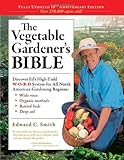Dec 292013
The Vegetable Gardener’s Bible (10th Anniversary Edition)
The invaluable resource for home food gardeners! Ed Smith’s W-O-R-D system has helped countless gardeners grow an abundance of vegetables and herbs. And those tomatoes and zucchini and basil and cucumbers have nourished countless families, neighbors, and friends with delicious, fresh produce. The Vegetable Gardener’s Bible is essential reading for locavores in every corner of North America!
Everything you loved about the first edition of The Vegetable Gardener’s Bible is still here: f
List Price: $ 24.95
Price: $ 9.96
More Gardening Products


Serious gardening…….,
Ed Smith is a serious gardener. His approach to vegetable growing is best suited to half acre gardens in the northern areas of the United States. Smith lives and gardens in Vermont and judging by the contents (great photos as well as text) of his book, THE VEGETABLE GARDENER’S BIBLE, I suggest his gardening effort constitutes year-round full-time employment for him. I am a dedicated urban gardener, but one with a less than one-eighth (<1/8) acre plot of land, much of which is covered by a house and driveway. I cannot begin to use most of the material in Smith’s book, however, even for urban gardeners like me, Smith provides much useful information.
My experience has shown that vegetable growing in the city has one advantage over growing vegetables in the hinterland…most of the pests that plague the countryside have not moved to town…yet! When I grew green beans on a half acre plot in the country, I fought a daily war with bean beatles. I’ve yet to see a bean beatle in my urban back yard. On the other hand, the larvae of the Monarch Butterfly found my parsley last year. Smith’s section on pests includes something I have not seen in other gardening books..a picture of Monarch Butterfly larvae or Parsley Caterpillers as Ed calls them, munching away.
Smith is an organic gardener so he advises pest control methods that deter unwanted visitors without damaging the larger envirnoment. He also advises moving the Parsely Caterpillar out of harms’ way when you battle other insects. However, the birds living in my yard consider Parsley Caterpillars a delicacy, much to the horror of my granddaughters who watched the pretty little green and yellow striped caterpillars with interest last summer as they grew bigger and bigger until one day they were discovered to have been eaten by a feathered predator who left only a few body parts in his wake.
Smith includes much that will be of interest to anyone setting out to grow vegetables for the fifteenth or first time. Although most of us don’t have a green house for winter gardening, most of us do have a sunny window sill that can be used to germinate seedlings for transplanting. Most of us can compost (check out WormWoman.com on the Internet if you live in an apartment).
Smith advocates growing vegetables in (W)ide rows, (O)rganically, in (R)aised beds with (D)eep soil. Even with my small yard, I can do that. We built raised beds with timbers, and filled them with compost made entirely of yard and kitchen waste and the result is fabulous. He provides a nifty section that shows you how to construct a raised bed on a patio or balcony. You may not have a half-acre spread, but you can use Smith’s Bible if you want to grow vegetables.
Was this review helpful to you?

|Excellent Reference,
This book is a reference manual for vegetable gardeners, particularly those gardening in northern climates. The book is organized into 3 main parts: From Seed to Harvest (covering planning, preparing beds, starting seeds, maintaining the garden, and harvesting), The Health Garden (covering soil, compost, and pests), and Vegetables & Herbs, A-Z (alphabetical guide to individual vegetables). The book is amply illustrated with color photographs and illustrations. End material includes zone maps, a list of suppliers, a list for further reading, and an index.
Smith sums up his approach to gardening in the acronym “WORD”, which signifies Wide rows, Organic methods, Raised beds, and Deep soil. He’s come to this approach after many years of trying many different methods, and found that this method seems to give him the best, most reliable harvest with the least effort. In this book, he explains the parts of the WORD method in detail. For example, he notes that he found rototilling actually to be counterproductive, since it tends to develop a hardpan of packed soil just under the surface. This hardpan limits root growth, which tends to stunt plants. Instead of rototilling, he advocates building deep raised beds, which provide for full root systems and better growth.
The articles in the alphabetical reference section are quite useful. Each includes a brief description of the vegetable, notes on when and where to plant, and notes on harvesting and storing. Instructions are also provided when needed about how to transplant. Each article comes with a quick reference chart that covers sowing (depth, temperature, days to germination, etc.) and growing (temperature, spacing, watering, companions, seed longevity, etc.) Overall, the book is very informative, the text is clear, and the pictures are quite helpful, making the book useful for experienced gardeners as well as beginners.
Was this review helpful to you?

|It’s a * * WONDER* * book!,
THANK YOU Mr. Smith for writing this book! I couldn’t say enough about how helpful it’s been to me. Wanting to be careful and do things right, since I’m a beginning gardener, this book tells in simple, everyday language with photos on how to start and keep up a vegetable garden. Here’s a list of a few things it covers:
* designing your garden
* insect control
* soil care
* what veges to NOT plant with other veges
* diagrams
* lots of veges and all the info you could want about them
* herb section
* seed companies
* other recommended resources
* and MORE
Was this review helpful to you?

|